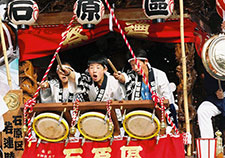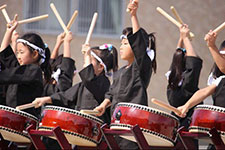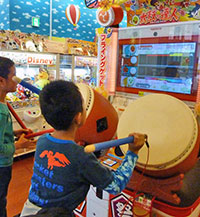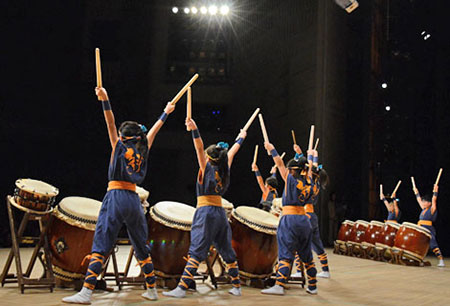Wadaiko Energize the Brain
In Japan, children have many opportunities to experience the fun and excitement of wadaiko. These include local festivals and school classes as well as performances at school sports and cultural festivals. In cities around Japan, the number of taiko schools is increasing, making it easy for anyone to give taiko a try.
 Children beat wataiko atop a float at a festival. © Kumagaya City, Saitama Prefecture
Children beat wataiko atop a float at a festival. © Kumagaya City, Saitama Prefecture |
 Kids perform on wadaiko at a sports festival in Kawasaki City, Kanagawa Prefecture. The drums seen here are hiradaiko, which have a shorter body and produce a lighter and higher sound than larger wadaiko.
Kids perform on wadaiko at a sports festival in Kawasaki City, Kanagawa Prefecture. The drums seen here are hiradaiko, which have a shorter body and produce a lighter and higher sound than larger wadaiko. |

A class employs wadaiko drumming for health. To maintain good posture, they do not use sheet music, instead learning songs by ear. © Taiko-Lab
Scientific research has shown that pounding away on a taiko can be mentally refreshing and also help to energize the brain. As a result, some people practice taiko to improve their health. One wadaiko school in Tokyo has even developed a type of aerobic exercise involving taiko in which the drummer steps while drumming. This taiko exercise has proved quite a sensation.

Children have fun pounding away on a taiko arcade game. The game shown here is “Taiko no Tatsujin” (Master Taiko Drummer) made by Namco Bandai Holdings. © Namco Bandai Holdings Inc.
Wadaiko are also popular in the video game area. There are games in which players compete to test their skill of playing the drum based on musical scores appearing on the screen. They are available in a number of platforms, ranging from big arcade games to those on home game consoles as well as on mobile phones. With new tunes constantly being made available in music for taiko, adults and children alike are able to enjoy taiko in a way resembling karaoke.
Powerful Stage Performance
In November, a grand taiko festival to determine a national champion was held in Saitama. For the first time, the taiko contest included a competitive division for primary school students and younger. Competing were six taiko groups that first qualified locally. They put on an amazing show that wowed the audience of nearly 3,500 people, showing skills that would nearly outshine almost any adult taiko troupe.

Members of a primary school team leap as they play nagado-daiko while performing at a taiko festival.
It is not only the rumbling sounds and rhythms of wadaiko that are interesting. Colorful outfits and flashy performances also help to make wadaiko a joy to watch on stage. In particular, the dynamic movements of children as they jump around, changing positions and beating on the nagado-daiko captivate the audience. Some teams also incorporate aspects of traditional dance while other teams remove their outfits with dramatic flare. After striking a powerful pose, performers punctuate their performances smartly with a bow in unison to the audience, conjuring images of a martial arts match.
The teams of kids showcased at the grand taiko festival have acquired their skills over time, through hard practice and performing at local festivals, events and welfare facilities. The leader of one team said that they perform nearly 50 times a year, adding, “We practice more than two hours around three times a week. Someday we want to perform on stages around the world.”

The sense of connection a team feels when they finish a performance makes for a precious memory at a taiko festival.
The art of Japanese wadaiko continues to evolve with time as it is passed on from generation to generation.
(December 2012)